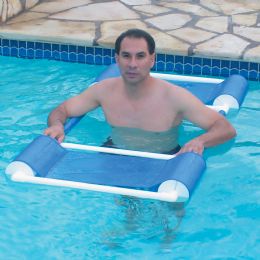














What is Aquatic Therapy?
Also referred to as water therapy and water exercise, aquatic therapy has many varied aspects. Treatments and exercise routines are performed while fully submerged, partially submerged or while floating in water. While some aquatic therapies are performed with the constant help or supervision of a trained therapist, others can be utilized individually. Even though aquatic exercise is most often employed for injured, disabled or aging individuals, don’t be fooled by the popular misconception that water therapy is solely intended for these individuals alone. Everybody of every age can enjoy this feel-good activity.
Simple walking, floating, swimming and running while submerged in water are all aquatic therapy activities that can be performed with or without the assistance of a trained therapist, and there are many floatation devices and wearable devices to help individuals perform these activities safely, even if they have no prior swimming experience. Other people prefer the use of underwater treadmills, elliptical machines and other equipment specifically designed for safe use in the water to boost their water workouts.
What are the Benefits of Aquatic Therapy?
Aquatic therapy can include aquatic exercise, aquatic bodywork, physical therapy, occupational therapy and hydrokinesiotherapy. Commonly used in orthopedic rehabilitation, aquatic therapy may also be called aquatic rehabilitation, pool therapy and therapeutic aquatic exercise. It is often employed in sports medicine and other areas of orthopedics such as work conditioning and back rehabilitation to help restore function. Aquatic therapies are especially beneficial in therapy programs where normal functioning is limited by pain, inflammation, muscle spasms, guarding and limited range of motion (ROM), or where indications for non-weight bearing movement is desired.
Therapeutic aquatic exercise is perfect for the reeducation of weak or injured muscles and for skill development in neuromuscular and neurological impairment applications, rheumatological diseases, acute neuromuscular or orthopedic injuries and for recovery from recent surgeries. Many aging or older adults find aquatic exercise to help immensely with issues of the natural changes that occur as we age, such as musculoskeletal systems, functional fitness, body composition and basic skills such as balance and walking. Children and adults with varying disabilities and physical and/or mental challenges often respond very favorably to aquatic therapy, as well.
Water remains the most excellent place for any individual to exercise, whether one is injured, disabled or able-bodied, as it allows for weight-bearing activities in a drastically reduced gravitational environment. Standing in water up to the waist reduces body weight by 50%, while standing in chest-deep water reduces body weight by 75%, and standing in water that is neck-deep reduces body weight by a whopping 90%! The buoyancy of water supports the body, reducing the amount of body impact on the bottom of the pool based on the depth of the water.
This reduction feels so good as it diminishes the load on the body’s joints, diminishing the pain that one feels on dry land against the resistance of gravity. This is helpful not only for individuals recovering from injury or surgery, but also helps to prevent problems that typically occur by jogging or running on dry land. Water helps minimize the amount of impact and stress to the joints. Yet the viscosity of water offers wonderful resistance for strength training.
The hydrostatic pressure of water is another great benefit of aquatic therapy. Acting as a compressor on the entire body, this helps to move blood more efficiently through the arteries and veins, which can ultimately reduce inflammation, swelling and edema. The water compression also helps the blood return to the heart, unlike exercising on dry land where blood tends to pool in our lower extremities.
Wave propagation and turbulence properties of water make it a great medium for safe and challenging aquatic exercise, as individuals can work against the turbulence or with it, allowing intensity to be decreased or increased. A temperature-controlled heated pool additionally factors into the aquatic therapy experience, as warm water increases peripheral circulation and facilitates muscle relaxation, decreased pain sensitivity and improved balance and body awareness.
Rehabmart is delighted to offer a multitude of superior quality aquatic therapy equipment from well-known and innovative manufacturers that include Aqua Creek, Rehab Systems, Hudson Aquatic, DuraCart, Danmar and Konfidence USA.
Hulet Smith, OT
Rehabmart Co-Founder & CEO
ck